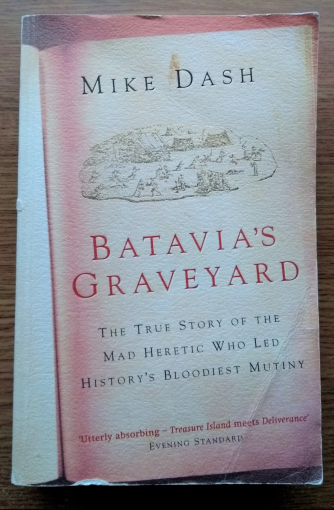 Title: Batavia’s Graveyard
Title: Batavia’s Graveyard
Author: Mike Dash
Time/Place: Netherlands and Australia, 1628
Teaser: ‘The skipper trusted to his own judgement, and he held the Batavia’s course, sailing with all her canvas set. When the ship struck, she therefore did so at full speed.’
Summary: The Dutch East Indiaman Batavia runs aground on a cluster of deserted islands close to Australia, stranding crew and passengers to the mercy of the elements. One group of sailors row in search of help, whilst on the island dubbed ‘Batavia’s Graveyard’, the mutineer Cornelisz commits murder.
My Thoughts:
I picked this book up in a charity shop. I walked past it more than once, but its unusual cover and title kept catching my eye until I decided to read the blurb. I bought it straight away, intrigued by the themes of sailing, mutiny and shipwreck, and especially by its comparison to Lord of the Flies.
The history: This book is a strange one, using a a writing style that stockpiles facts without a protagonist or narrator. I found this jarring at first, putting it down to ‘info-dumping’, until I came to realise that the book is a bridge between a novel and a piece of non-fiction, and one that only just edges into the fictional genre. It does take a fair bit of getting used to, and requires plenty of reader concentration to take in a lot of connected facts, but it is an effective way for Dash to cover large swathes of history, time and several distant locations, and provides much more background to Corniliez than a ‘normal’ fiction book might be able to. It was the mutiny that I was most interested in – nautical history is something I often find interesting but rarely understand, and it slots nicely alongside the ‘boy’s own’ genre of books like Treasure Island that I enjoyed when I was younger. I’d never heard of Corniliez before, and I definitely came away from this book knowing more about a strange phenomenon in the history of shipwrecks and sailing, as well as with more understanding of trade in the Netherlands and the landscape of Australia in the seventeenth century. Even if you already knew about the period and events, I imagine this book would keep finding ways to surprise you.
The story doesn’t follow particularly traditional lines. There are no leading characters, and Corniliez becomes the focus of the book much later than one would expect. Although his background is explored via historical facts about his early life, there is no standard characterisation. This can sometimes be confusing – there are an awful lot of names thrown around without full expansion – but becomes an effective way of telling a complex story. The narrative jumps between past and present, sometimes at random, expanding on pieces of history as it chooses and keeping the reader on their toes. Overall, I would have liked to see more about life for the survivors on the islands and less about the story of the Batavia before it set out on its voyage, but this is still a fascinating read with plenty of tension, especially towards the end.
My favourite character was the fanatic Cornelisz, as his areas of the book were by far the most driven and tense.
Recommended: When it comes to non-traditional historical writing, this is a great place to start to find out if it’s for you.
My Rating: 4/5
Advertisements Share this:




